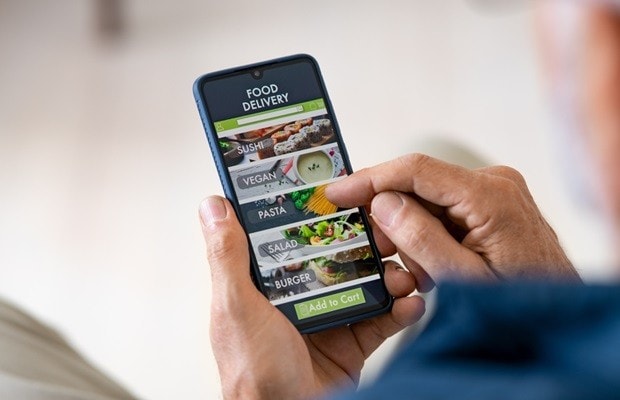

1. Streamline your delivery menu
The larger your menu, the more ingredients you’ll have to store, the more dishes you’ll have to train staff to create and the more room there is for things to go wrong. Carefully consider what dishes you’ll offer for delivery and put only the dishes on the menu that you know will travel well. Try to put dishes on the menu with overlapping ingredients too. This will help you to track your inventory and reduce food waste.
Not only will a shorter menu make it easier for you, but your customers will appreciate it too. People use delivery apps for convenience, so shorter menus that are clearly categorised are easier to navigate within apps and generally make it quicker to place an order.

2. Organise your kitchen
Organisation is vital to ensuring your kitchen runs efficiently. Start by creating designated prep spaces for each staff member or dish category and ensuring equipment is organised and tidy. Encourage your staff to clean as they go, not only for efficiency but for better food hygiene too.
Keeping an inventory of your ingredients is also essential. This will ensure that you know what you’ve got, when it goes out of date, what needs replenishing and what, if anything, you’re wasting. Use the first in, first out method of organising ingredients in your walk-in or dry store and make sure everything is clearly labelled. Store inventory sheets in visible areas so all staff can see and keep track.
Of course it helps if your kitchen is laid out efficiently to begin with too. Organising your space will allow staff to move easily through the kitchen and reduce bottlenecks. Trying keeping distances between workstations as short as possible – always ensuring safety – to minimise the time staff spend moving around.

3. Know your food costs
One of the most important things to know about your food business is your costings. With the cost of ingredients and utilities increasing, you need to know how much each dish is costing you to prepare and deliver and consequently what profit margin you’re making with each order. Use our free cost calculator to price up each of your dishes with ease.

4. Focus on delivering value: Don’t just increase your prices in order to increase profit
The cost of everything is going up right now, so you’ve more than likely had to increase your prices in order to protect your bottom line. But if you really want to offer your customers value whilst boosting your profitability, it’s best to encourage consumers to buy more items per order, or choose more premium options, rather than just marking up prices. According to Kantar, it’s the value of foodservice transactions that’s driving post-pandemic recovery, not the volume[2].
5. Work with aggregators to streamline your food delivery operation
Delivery aggregators, such as Just Eat, Deliveroo and Uber Eats, can really help to streamline your delivery operation. Partnering with them to manage your deliveries not only opens your business up to a new customer base, but you benefit from their technology too. Once you’re a partner, they’ll install their hardware in your restaurant meaning that you can manage orders and help customers track their deliveries in real time – without you having to invest in your own technology. Find out more about how to make the most of your aggregator partnerships here.
Sources
[1] “Foodservice delivery: Defining customer missions”, IGD, January 2023
[2] “Dining out at home: How meal delivery is transforming foodservice”, Kantar, November 2022